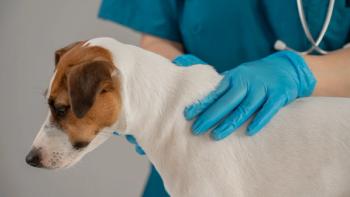
Demodicosis most common underlying cause of persistent pododermatitis
Since a deep secondary pyoderma is usually present, a culture and sensitivity is usually performed.
There is nothing more frustrating than treating a dog with bacterial pododermatitis.
You can use antibiotics, foot soaks in antibacterial soaps, and sometimes a small dose of steroid, and this infection keeps lingering!
The most common underlying cause of a persistent pododermatitis is demodicosis. In some patients, only the feet will be involved. In some cases, just one foot is effected.
The clinical presentation of a dog with demodex pododermatitis is usually a swollen foot, particularly around the nailbeds often with accompanying deep infection. (See Photo 1.)
Photo 1: Inflamed, swollen foot with demodex mites and accompanying infection.
If skin scrapings are not performed or the mite is missed and the dog is treated with antibiotics and steroids, the feet improve. Unfortunately the steroid leads to more immunosuppression, and the patient's feet flare up worse than on the original presentation.
If the mite is missed again on scrapings, more of the same medications are dispensed typically. The patient enters a cycle of improvement, yet worsens over time. Another common mistake is to check the patient's feet for yeast and dispense appropriate anti-yeast medications yet when demodex is present, the yeast is a secondary problem. In essence, diagnosing the mite is essential to clearing up any secondary bacterial or fungal infection.
The diagnosis of pododemodicosis is made by deep skin scrapings of the effected feet and observation of the mites in oil under low power. (See Photo 2.) In some patients, plucking the hairs of the feet will enable one to visualize the mite adhering to the root of the hair. Since a deep secondary pyoderma is usually present, a culture and sensitivity is usually performed. In some patients on chronic steroid use, demodex infections will develop.
Photo 2: In some patients, plucking the hairs of the feet will enable one to visualize the mite adhering to the root of the hair.
In those patients, in order to eradicate the mite, an alternate therapy to the steroid needs to be undertaken along with treatment for the mite. In older patients not on steroids that develop demodex of the feet, an internal medicine workup should be undertaken to rule out neoplasia, Cushing's disease, hypothyroidism or underlying chronic allergy. (See Photo 3.)
Photo 3: Demodex of the feet/legs in a Shetland Sheepdog with transitional cell carcinoma of the bladder.
Long-term antibiotics
Treatment of pododemodicosis can be difficult because of the accompanying infection.
Long-term antibiotics should accompany one of the three treatments for demodex. The only FDA-approved treatment for demodex is mitaban dip. These dips are approved for biweekly use, but the success rate doubles when dips are performed weekly. Dips should be preceded by a benzoyl peroxide shampoo of the feet for its follicular flushing activity. (See Photo 4.)
Photo 4: Demodex of the feet-more chronic with crusting, hyperpigmentation.
The patient should be discouraged from getting its paws wet between dips, which makes these dips difficult to use in patients that go outside. If the owner is performing weekly dips, they should be cautioned not to use the medication on dogs if they are pregnant, diabetic, on antihypertensives, cardiac medications or antidepressants.
Once the mites have been eradicated, we suggest that the patient have four more weekly dips as insurance. Along with the dip and benzoyl peroxide shampoos, antibiotics need to be prescribed for the entire treatment regimen. Do not prescribe steroids, not even a small amount! In some patients a "small" dose of steroids is enough to perpetuate immunosuppression that the demodex mite is causing anyway. Ivermectin at 200-800ug/kg/day orally is another treatment for demodex of the feet. It is not FDA-approved for use in the dog for demodex and should not be used in herding breeds, herding breed mixes, white German Shepherds or in elderly patients. The patient should be heartworm negative before starting therapy.
It is an inexpensive way to treat demodex and can work well in the right patient. Its use is accompanied with antibiotics, benzoyl peroxide baths of the feet (without steroids). We recheck skin scrapings at monthly intervals, and the ivermectin is continued 60 days past a negative scraping.
Neurological side effects including ataxia, drooling and lethargy have been reported even after the patient has been on the drug for weeks, so it is important to warn the client to watch for any unusual problems. (See Photo 5.)
Photo 5: All four feet effected with demodex pododermatitis - alopecia, erythema, swelling.
Milbemycin has been used for demodex of the feet at a dose of 0.5-l mg/kg twice daily after testing negative for heartworm. Again, antibiotics and benzoyl peroxide shampoos of the feet should accompany the therapy. It is used in herding breeds or older patients where ivermectin cannot be used. It is a good idea to start at the low end of the dosage range because occasionally a Collie or Shetland Sheepdog will have neurological side effects. It is used until 60 days after a negative scraping.
It is not a good idea to combine any of the above therapies if you are using mitaban dips. Do not add on milbemycin or ivermectin or vice versa. In some patients when using one therapy you may find that the patient has reached a plateau, and you are not seeing any further improvement. In that case, it is probably a good idea to change to one of the other therapies. For example, I had immediate improvement in a patient on milbemycin, but after three months I was still finding mites on scrapings, albeit reduced numbers. We changed that patient to oral ivermectin, and he cleared in another month.
Photo 6: Swelling of the skin surrounding the nailbeds with the characteristic odor of deep infection.
Each patient is different in that one may respond well to ivermectin and not milbemycin and vice versa.
When rechecking skin scrapings or hair plucks, your goal should be to eliminate all signs of mites (dead or alive). Always accompany your mite therapy with antibiotics and bathing of the feet, and don't touch those steroids! In older patients that develop demodex of the feet, be sure to search for an underlying cause.
Suggested Reading
- Scott DW, Miller WH, Griffin CE, Muller & Kirk's Small Animal Dermatology, 6th Ed, WB Saunders, Philadelphia, 2001.
- Kwochka KW, Willemse T, von Tscharner C, Advances in Veterinary Dermatology, Volume 3, Elsevier, UK, l998.
Newsletter
From exam room tips to practice management insights, get trusted veterinary news delivered straight to your inbox—subscribe to dvm360.




